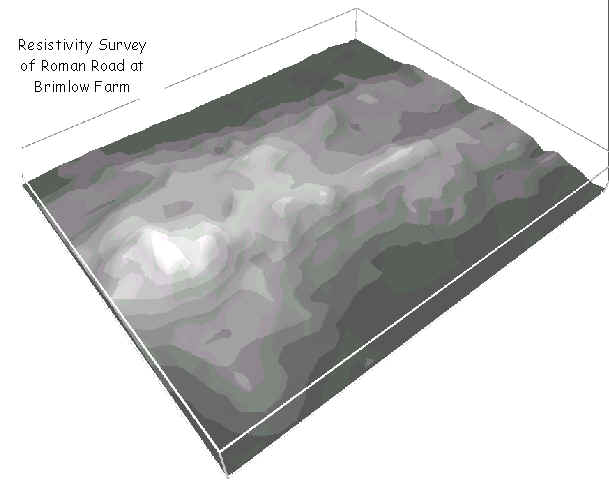|
Things have been a little hectic this month with a number of site visits. It all
started when a small group of us descended on Brimlow Farm to inquire about the
possibility of doing some resistivity work.
It was a bright sunny day and Roy Brandon, the farmer, was away on holiday but his
deputy said we had a couple of weeks in which to do something in the north field before it
was re-seeded. Both fields in which we are interested are used these days for
growing turf, which is great for us because the archaeology is not disturbed. The
south field was ready for lifting and we thought it best to not go on it without
Roy’s permission. We finished the afternoon by re-familiarising ourselves with
the area before going off to look at the site where the pipeline crosses the line of the
Roman Road at Hic Bibi. Unfortunately, nothing of the road could be detected in the
disturbance caused by the contractors.
Dry Run
Before launching into a full-scale survey of an important site such as the Roman road
with our new equipment, I thought it prudent to do a proper field trial. This was
duly completed the following weekend in Tim McVoy’s back garden - he happens to have
a convenient half-acre. The day was hot and the ground was dry and hard.
We learned quite a lot that day especially about techniques of marking out a grid and
how to straighten bent probes. The results were duly processed and plotted using the
Vumate software and, although not making much sense to us, they gave Tim quite a lot to
think about.
Wet Run
Armed with new skills, the following Saturday we mustered once again at Brimlow.
The weather had turned cold now and it had started to rain. This time Roy was back
from holiday and remembered me from the last time we worked there over twelve years ago.
He has always been enthusiastic about the historical significance of his farm which
records show dates back to the 14th century. He was therefore keen to show me the
interior of his farmhouse, which he is currently renovating. In many of the rooms
where the plaster has been stripped way, the wood frame of the original building is
clearly visible. Although not a full ‘cruck’ frame, the large timbers are
obviously hand cut and therefore most likely date from around the 16th/17th century.
Roy intends to preserve these and display them as a feature of his new interior.
By the time we got around to doing the survey the rain had set in but we were
determined to do something. We managed to re-establish the datum line of the
1980’s work and from this we marked out an area for survey 25 x 30 metres, adjacent
to the previous survey. We would have started to take readings but the logging paper
was saturated so we agreed to try again the following morning.
Results
The next day the rain had stopped and the field was fortunately not water logged.
It took us a good 2 hours, however, to complete the survey of over 800 readings. By
the time we had finished, it was obvious that the field had began to dry out and to
confirm our suspicions we did a quick run across the 1st grid positions of each row.
The difference from the original readings proved a gradual increase in the ground
resistivity. Using these readings, however, I was able to re-calibrate the data to
give a more accurate plot. The results as you can see show a significant ridge
running north-south up to 14 metres wide. From this it is now possible to project
the line across to the other field. Towards the north end there is a peak of high
resistance, which coincides with a widening of the section. This could indicate some
feature crossing the road at 90 degrees.

More surveys
The next survey we do will be the south field at Brimlow, the date for which I will
arrange at the meeting. In the mean time we have been looking at a possible site in
Higher Ince where the Roman road from Manchester to Wigan is supposed to cross Amberswood
Common. If you want to be involved in this work in the future please contact me at
the meeting.
Trip
The date for this year’s summer trip has been suggested for Sunday 6th August and
the probable destination is Carlisle with its Norman castle and splendid museum. Not
far up the road is Birdoswald Roman Fort, the site of recent significant excavations.
These have shown that occupation carried on here well after the official Roman
withdrawal from Britain at the end of the 4th century AD. The site now has a
visitor’s centre where the archaeology is explained. To give us an indication
of numbers please fill in the form below if you are interested.
Next Meeting
Wednesday 6th June at the BP Centre (Scout HQ) in Greenough Street, at 7.30 pm as
usual. This month’s speaker is Dr Robert Philpot from Liverpool Museum, who
will be revealing details of recent Roman finds from the South Lancashire area.
Hope to see you at the meeting - B.A.
|



